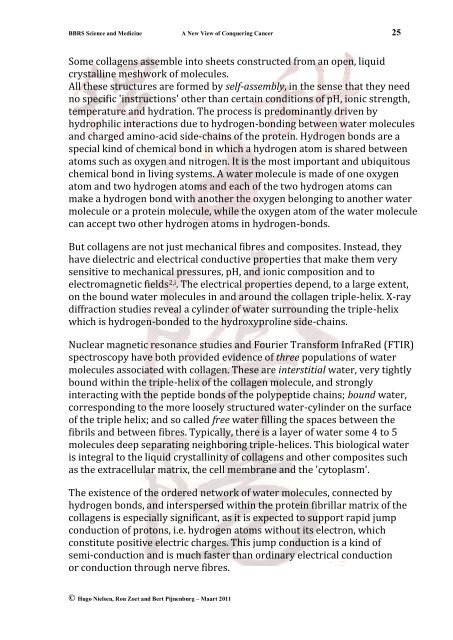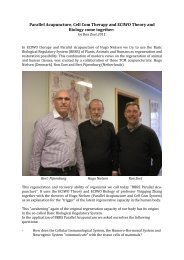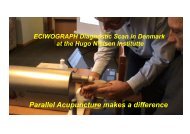BBRS SCIENCE AND MEDICINE RON ZOET Biocommunication ...
BBRS SCIENCE AND MEDICINE RON ZOET Biocommunication ...
BBRS SCIENCE AND MEDICINE RON ZOET Biocommunication ...
Create successful ePaper yourself
Turn your PDF publications into a flip-book with our unique Google optimized e-Paper software.
<strong>BBRS</strong> Science and Medicine A New View of Conquering Cancer 25<br />
Some collagens assemble into sheets constructed from an open, liquid<br />
crystalline meshwork of molecules.<br />
All these structures are formed by self-assembly, in the sense that they need<br />
no specific 'instructions' other than certain conditions of pH, ionic strength,<br />
temperature and hydration. The process is predominantly driven by<br />
hydrophilic interactions due to hydrogen-bonding between water molecules<br />
and charged amino-acid side-chains of the protein. Hydrogen bonds are a<br />
special kind of chemical bond in which a hydrogen atom is shared between<br />
atoms such as oxygen and nitrogen. It is the most important and ubiquitous<br />
chemical bond in living systems. A water molecule is made of one oxygen<br />
atom and two hydrogen atoms and each of the two hydrogen atoms can<br />
make a hydrogen bond with another the oxygen belonging to another water<br />
molecule or a protein molecule, while the oxygen atom of the water molecule<br />
can accept two other hydrogen atoms in hydrogen-bonds.<br />
But collagens are not just mechanical fibres and composites. Instead, they<br />
have dielectric and electrical conductive properties that make them very<br />
sensitive to mechanical pressures, pH, and ionic composition and to<br />
electromagnetic fields 2,i . The electrical properties depend, to a large extent,<br />
on the bound water molecules in and around the collagen triple-helix. X-ray<br />
diffraction studies reveal a cylinder of water surrounding the triple-helix<br />
which is hydrogen-bonded to the hydroxyproline side-chains.<br />
Nuclear magnetic resonance studies and Fourier Transform InfraRed (FTIR)<br />
spectroscopy have both provided evidence of three populations of water<br />
molecules associated with collagen. These are interstitial water, very tightly<br />
bound within the triple-helix of the collagen molecule, and strongly<br />
interacting with the peptide bonds of the polypeptide chains; bound water,<br />
corresponding to the more loosely structured water-cylinder on the surface<br />
of the triple helix; and so called free water filling the spaces between the<br />
fibrils and between fibres. Typically, there is a layer of water some 4 to 5<br />
molecules deep separating neighboring triple-helices. This biological water<br />
is integral to the liquid crystallinity of collagens and other composites such<br />
as the extracellular matrix, the cell membrane and the 'cytoplasm'.<br />
The existence of the ordered network of water molecules, connected by<br />
hydrogen bonds, and interspersed within the protein fibrillar matrix of the<br />
collagens is especially significant, as it is expected to support rapid jump<br />
conduction of protons, i.e. hydrogen atoms without its electron, which<br />
constitute positive electric charges. This jump conduction is a kind of<br />
semi-conduction and is much faster than ordinary electrical conduction<br />
or conduction through nerve fibres.<br />
© Hugo Nielsen, Ron Zoet and Bert Pijnenburg – Maart 2011





